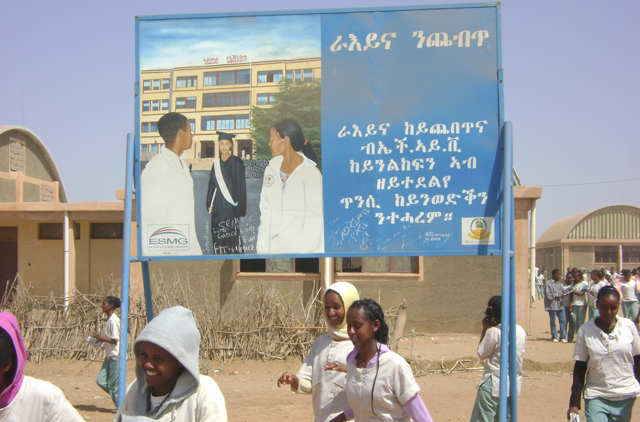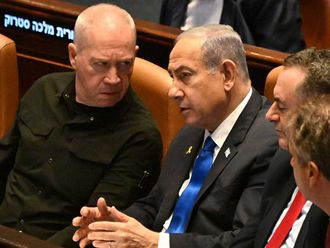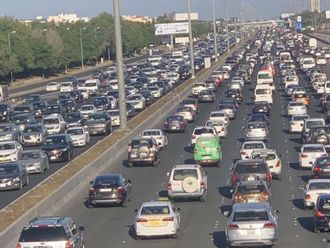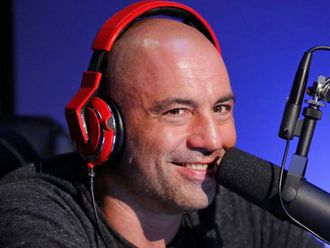
Asmara: On December 23 the United Nations Security Council imposed an arms embargo and other sanctions on Eritrea for endangering the stability in the Horn of Africa. Resolution 1907 was adopted to punish Eritrea for supplying arms to Al Qaida-linked Al Shabab rebels in Somalia and occupying disputed territory on its border with Djibouti.
In pictures: Military camp in Eritrea
The sanctions, which include an arms embargo, freezing of assets and travel restrictions on the political and military leaders, follow Western media and Eritrean opposition's campaign that Eritrean army camps were being misused to provide training to Somali militants and these camps were a haven for foreign fighters and Al Houthi rebels of Yemen.
To find out the truth Gulf News inspected military camps to make an objective and impartial report.
Eritrean officials said that Gulf News was the first foreign newspaper to penetrate into its military camps and take photographs since the creation of Eritrea as a sovereign state.
EXTENSIVE TOUR: The Gulf News team started the tour from the military camp of Sawa on the region bordering Sudan, and then moved south to the coastal city of Assab.
The team toured extensively the city of Sawa and its old oil installations, three camps in Kaleema — Iraq, Horaina and Saleena — Jabel Ras Doumeira, from which Eritrean authorities had earlier banned entry by a UN delegation as part of its probe into the border conflict between Eritrea and Djibouti in May 2008, the Haleb peninsula, Raas Dorma, which is regarded as the largest military zone in the Assab or southern Red Sea region and where the headquarters of the Eritrean regional naval command is located.
Other camps visited included Qalaalu, Iklilo and Fatima berth. Then we moved on to the north to visit Massawa port and Dahlak peninsula, about which some Arabs allege that there were missile launchers used by Israel and occasionally by Iran.
Sawa Camp: The Sawa Camp, which is also known as Sawa Defence Training Centre, is located 35km northwest of the Eritrean capital Asmara and very close to the Sudanese border. Earlier, it was open for Sudanese opposition forces, which used it to train their cadets. It was also important for the Eritrean Army during its war with Ethiopia.
Sawa camp, a full-fledged military city with all utility services, is regarded as the largest military camp in Eritrea, and is spread over 1,800 hectares. Now it is turned into the only military compound for conscription of girls and boys for mandatory military training.
THE CONTROVERSY: The Sawa Centre for Mandatory Military Service became controversial mainly because of the claims by the Eritrean opposition that it is a big prison camp. On the other hand, the government considers this a centre for developing human resources.
However, the problem is that there is a distinct difference between the mandatory military service prevalent in Eritrea and other countries. In Eritrea, military service is open and not for a fixed period of time. The youths are not allowed to travel abroad seeking better career prospects.
FINDINGS: The Gulf News team could not see any military forces except pupils. The camp consists of several ready-made air-conditioned buildings, shooting ranges, a desalination plant and electricity facilities.
Colonel Irza Wald Gabriel, director of the camp, disagrees with calling this facility a military camp. On the other hand, he preferred calling it "Rehabilitation Centre for Human Cadets".
There are about 5,000 pupils at the centre. Each year, teenagers come to the camp to complete their high school education, spending their 12th grade year combining normal academics with military training.
During our tour, both by vehicle and on foot that lasted for nearly two hours, we did not see any evidence or indication of the presence of any foreign forces including Somalis, Ethiopians or Iranians.
Gulf News entered several class rooms. In the computer classroom, we counted about 450 computers. About 1,500 students in the camp are using them taking turns. We had the feeling of being in a school campus rather than in a military camp.
After leaving the camp, it was evident from my observation that the charges circulated by the foreign media against Eritrea were indeed baseless.
JOURNEY TO ASMARA: In our long and arduous road trip to Asmara, we passed the regions of Agordat and Keren. Abdullah Damir, who accompanied us, hails from Agordat. It is worthy to note that Keren, a city with all the features of Sudan, was a major battle ground during the Second World War.
After securing a security permit to travel by road through the Red Sea coastal regions to Massawa and Assab in the south, we set out for our next destination. Okhlilo, who is a skilled driver from the protocol department, was driving a land cruiser, taking us to different destinations. He took us through a winding and zigzag mountain pass road leading to Massawa with picturesque scenery on both sides of the route.
Our journey to Massawa and Assab took 11 hours.
After reaching Assab city, we moved to the military command headquarters. We were received there by General Quraz Qabar Andriyam, commander of the military zone of the South Red Sea Region.
CENTRE OF CONTROVERSY: We moved to visit the oil refinery in Assab. The refinery was at the centre of controversy after the Western and Eritrean opposition alleged that Asmara used the Iranian expertise for its upgrading, and that Iranian Guards have been appointed for its security.
They also accused the Eritrean government of keeping a large number of Iranian troops and weaponry at the refinery and that their number was greater than what was actually needed for the security of the refinery.
TIES WITH IRAN: Observers familiar with the geopolitics of the Middle East point to the visit of Eritrean President Isaias Afewerki to Iran in May 2009 and talks with his Iranian counterpart Mahmoud Ahmadinejad as the catalyst for Western intelligence agencies to link Eritrea with Iran.
GULF NEWS FINDINGS: What we had seen inside the facility was only an old, abandoned oil refinery. There were neither any foreign soldiers nor even Eritrean troops, except two security guards at the gate.
We could see only the security guards at the refinery gate. The refinery, which dates back to Ethiopian colonial rule, consists of around 30 large, medium and small fuel tanks, some of them rusty and in a state of dilapidation.
We were accompanied on the trip to the refinery and other destinations in the Southern Red Sea Region by Colonel H.Q.P., and Major Q.J., an intelligence officer in the city. We toured the entire area of the abandoned refinery.
The Gulf News team failed to see any foreign presence during the tour to Assab, a small, poor city inhabited mostly by members of the Muslim tribe Fa'ar. Assab was part of the Afar Sultanate before the Italian invasion of the Horn of Africa and the Red Sea region.
The Israeli daily newspaper Maariv published a report on April 2, 2009, which says: "Iran has already finished building a naval base, at a desert area near the Eritrean port of Assab and close to its border with Djibouti. Tehran had transferred to this base — by ships and submarines — troops, military equipment and long-range-ballistic missiles… that can strike Israel." The Israeli daily also claimed that Iranians are using small drones to protect this base.
The newspaper claimed its information was based on reports from Eritrean opposition members, diplomats and aid organisations, without giving specifics. Gulf News did not pay a visit to Assab port, for which prior permission is essential. Gulf News had not sought permission from the Eritrean authorities for the visit to the controversial port. This correspondent regretted failing to seek permission to visit this important Eritrean port.
However, Eritrean commanders claimed in interviews that these reports were ridiculous and baseless.
Kaleema Camp in Assab: At 5.30am on Wednesday, February 10, the Gulf News team set out for the naval command headquarters in Assab city. We were accompanied by the same military officers who later escorted us to Kaleema and Raas Doumeira on the border region of Eritrea and Djibouti.
They were Colonel H.Q.P. and Major Q.J., an intelligence officer in the city. Travelling in a separate Hilux vehicle, they guided us on to Kaleema military camp. The Kaleema camp was in the limelight as the one purportedly used by Asmara to provide training to Al Houthi rebels of Yemen. The time was 6.15am when we passed the Assab refinery zone and entered an asphalt road, which is one of the best roads in Assab.
We moved southward passing the border of Assab city and then moved westward through a long mud road until reaching a security zone from where a soldier called Jama'a Abu Bakr Minita joined the military officials in the trip. Our trip was then northward thorough a plain land punctuated with rocks here and there.
Kaleema camp consists of three camps — Iraq, Horaina and Saleena. We toured the camps and took their photographs. We did not encounter any objection from the accompanying officers or any others.
Abdullah Damir, our associate in the journey, had served as a media person during the last years of the Eritrean Revolution. He belongs to the ruling Peoples Liberation Front.
GULF NEWS WINS WHERE UN TEAM FAILS: A VISIT TO JABEL RAS DOUMEIRA:
Background: In mid-June 2008, Djibouti President Esmail Omar Guelleh accused Eritrea of beginning a battle with his country on the Jabel Ras Doumeira border region.
Attending a meeting of Intergovernmental Authority on Development, IGAD, (of which Eritrea is also a member though boycotting its activities at present) in Addis Ababa, Guelleh said that at least 12 Djibouti soldiers were killed and another 55 wounded during the two-day clash.
The relations between Eritrea and Djibouti remain strained to this day.
In January 2008, Djibouti announced that Eritrea invaded its territory and occupied Jabel Ras Doumeira, a small mountain surrounded by an uninhabited region full of sand.
It is noteworthy that Djibouti, with a population of about 700,000 — one of the poorest countries on the planet — enjoys the support of France and Britain whose military bases it is hosting. On the other hand, Eritrea, with a population of over 4 million, has had strained relations with Ethiopia over a long-standing border dispute. Eritrea has also political differences with Uganda and Kenya.
This was because of the allegations by Uganda and Kenya that Eritrea was behind the anarchy in war-torn Somalia.
GULF NEWS TOUR: We set out from Kaleema camp to Ras Doumeira. When we reached Rakheeta village, we noticed a huge signboard, "Eritrean Djibouti friendship."
It was not on our itinerary to visit this place. But we had a stopover there as it was on our route, and the military officials were seen taking photos of the place.
The Gulf News team was allowed to climb Ras Doumeira and take photographs despite the presence of hundreds of soldiers positioned at various spots as well as inside caves in this strategic mountainous location.
GULF NEWS FINDINGS: We could not see any Iranian soldiers in Ras Doumeira camp. There were no sophisticated weapons or latest technological devices pointing to the presence of any troops from Iran or any other foreign countries in this camp contrary to the allegations made by the Western media. The media had cited the banning of a UN delegation to this place as evidence of the presence of Iranian troops there.
President Afewerki and a number of senior officials of the ruling Peoples Liberation Front, denied this allegation vehemently. They told Gulf News that the denial of entry to the UN delegation to this strategic location was to protest the adoption of the UN resolution condemning Asmara. "If their permission for entry was before this resolution, the UN delegation would have been allowed to enter the region," they said.
VISIT TO NAVAL BOATYARD IN HALEB ISLAND: Bilateral relations between Eritrea and the Western countries, especially the United States, are now at their worst level.
According to observers and political analysts, the intelligence agencies of the United States and some Western states accuse Eritrea of allowing Iran to build a naval yard for fast warships on its Haleb island, one of the major islands in the Assab Gulf on the southern coast of Red Sea facing Bab Al Mandab Strait on the strategic international shipping route.
Earlier, during the administration of former US President George W. Bush, US Assistant Secretary of State for African Affairs Jendayi E. Frazer made some critical observations about Eritrea. She observed that the US intelligence agencies had evidence that the Eritreans were providing military assistance to terrorists and therefore, the US government was likely to declare Eritrea as a "state sponsor of terrorism".
The US official also warned the Horn of Africa nation of severe economic sanctions. The US was successful in the adoption of UN Security Council Resolution 1907 imposing sanctions on Eritrea, and that was realised with the support of Eritrea's neighbours, Ethiopia, Djibouti and Kenya.
IN THE LIMELIGHT: Haleb Island had been in limelight for a long time following allegations by the Western intelligence agencies and a hostile media campaign that it was being used by Iran for its naval purposes.
During the tour of the Eritrean strategic military facilities, Gulf News was keen on knowing if there was any fact in these allegations and what exactly was taking place on the island.
I did not visit all parts of Haleb Island as I had not sought permission. Also, Eritreans were not ready to give me permission to make an inspection tour of the remaining parts of the island. Therefore, it was impossible for me to state precisely about anything taking place on that part of the island.
However, I visited the controversial boatyard and met with its Deputy Director Aman Yabio Mohammad Nour. The officer in his 40s spoke in fluent Arabic, thanks to his stay in Sudan for some time. We also met a number of employees at the yard called Harena Boatyard.
Nour disclosed that the Eritrean government sought foreign expertise for the functioning of the boatyard. "Experts from Italy and Australia used to visit the yard several times in a year and that was in accordance with specific and scheduled programmes.
"They also provide training to Eritrean technicians at the boatyard in addition to giving necessary consultancy and expertise," he said adding that the boatyard management concluded several contracts with specialised companies in those countries in this respect.
Nour continued saying: "You are the only foreign media person visiting this peninsula, which has a total area of 180 square metres. It is noteworthy that the boatyard was constructed in 1987 when Eritrea was under the rule of Ethiopian invaders.
Later, the Ethiopian government sought the help of a Korean company for its operation. After Eritrea won independence from Ethiopia, Asmara developed the boatyard with the support of Italian and Australian experts in 1998. The boatyard produced both wooden- and steel-hulled craft. There were also two types of fibre boats meant for security and fishing purposes.
I also happened to notice that the intelligence officer who accompanied us was carrying a firearm. I saw the weapon under his shirt when he got down from the vehicle to see us off at the headquarters of the military command in Assab city.
SMUGGLERS FROM AFAR TRIBE ACTIVE BETWEEN YEMEN AND ASSAB: While we were taking rest at Kebal International Hotel Assab, we were acquainted with a relative of Abdullah Damir, who accompanied us on our tour. During the conversation, the man, a resident of Assab, told us a story about people from the Eritrean tribe of Afar.
These tribesmen were engaged in smuggling in of foodstuffs from Yemen by sea. While they were engaged in smuggling, some of these people were caught red-handed by the Yemeni navy. This was at a time when the battle was raging between the Yemeni government forces and Al Houthi rebels. He told us that we could get more details about these smuggling activities from the Shaikh of Afar.
But Damir vehemently opposed my plan to visit the Shaikh of Afar, who lives in Assab city. He rejected my request on the pretext that it was not part of our itinerary. I spared no efforts to convince him that it would be a humanitarian act to absolve the Afar tribesmen of their alleged involvement in smuggling weapons to Al Houthi rebels. He said: "The Yemeni authorities know well that these tribesmen were engaged in smuggling of foodstuffs and sheep and this was not the first time. And it is not your business to go in to its details."
Then I tried to contact the Eritrean Information Minister personally by phone, but to no avail.
DAHLAK ARCHIPELAGO BETWEEN IRANIAN AND ISRAELI DESIGNS: We left Assab city and returned to Massawa. We were accompanied in the trip by Colonel H.Q.P., and Major Q.J., the intelligence officer from Assab city. Our next and last destination in Assab city was the military camp in Raas Dorma or Turma.
It is regarded as the largest military camp not only in Assab but in the entire southern Red Sea region. It is located 40km north of Assab toward Massawa and 20km from the international waters. It enables the Eritrean navy to closely monitor foreign ships passing through the international waters.
Talking about the strategic significance of the largest naval berth at this camp, Colonel H.Q.P. said that the military personnel stationed here were tasked with monitoring and safeguarding the regional waters of Eritrea. On the other hand, I noticed scores of military units deployed on four square kilometres around the camp.
There are hundreds of fortifications on the rocky plain and they are supposedly for defence purposes as well as for conducting shooting exercise.
I bid farewell to the military officers, who accompanied me. Colonel H.Q.P. stayed on at the headquarters of his command at Raas Dorma camp while Major Q.J. returned to Assab city. We resumed our journey to the coastal city of Massawa for our next destination of Dahlak archipelago.
HISTORY: Yaqut Al Hamawi, one of Islam's greatest geographer-historians, says in his encyclopaedia Mu'jam Al Buldan that the Umayyads used to deport those in their hit list to Dahlak Archipelago and that the prominent figures, who had to lead a life in exile on the island, included noted poet Omar Bin Abi Rabia.
The Umayyad Caliph Omar Bin Abdul Aziz was fed up with his poetry, mainly about women, and forced him into exile in the island where the poet died in 712 Hijri era.
Even though Eritrea has at least 126 major islands of various geographical sizes in the Red Sea, the Dahlak Archipelago is the largest among them. It consists of two large and 124 small islands. There are also some groups of islands such as Danakel islands and Fatima and Haleb islands. Fatima and Haleb islands are regarded as more significant among them, taking into account their strategic location, overlooking Bab Al Mandab Strait.
Fatima and Haleb islands are located 22km and 20km from the international shipping route respectively.
I did not visit Fatima Island but rumours of an Israeli military presence on the island for several years have circulated in the Arab street.
Eritrea wields its strategic domination over Bab Al Mandab mainly because of these two islands.
Dahlak archipelago has been in the midst of controversy over the past 20 years ever since Eritrea's independence. Sometimes it was said that it was used by Israel as its missile launch pad. Another allegation was that Eritrea allows Iran to assemble its military hardware there.
Our trip to Dahlak archipelago was in a speed boat of the Eritrean navy. It took one and a half hours to reach the group of islands, 55km from Massawa. I got down at the naval berth. I took photographs of the headquarters of the naval forces that consist of smaller buildings.
GULF NEWS FINDINGS: We made a thorough inspection of the island's interiors. We saw several wild animals, including gazelle in the jungles there. Our tour also covered six villages, inhabited mainly by tribesmen called Dahalika, and some other tribes including Afar.
There are three elementary schools in these villages, with poor infrastructure. There was only one health centre and a small desalination plant in addition to a number of administrative buildings.
We could not see any military manoeuvres other than the routine one. We tried but failed to see any missile launch pads as alleged by the Eritrean opposition. Contrary to Eritrean media reports, we could not find any major tourism projects in this strategic island.
The soldier, who drove the speed boat, told us that there are 365 islands that belonged to Eritrea in the Red Sea. Dahlak, spreading over an area of 93 square metres, is the largest among them. The smaller islands range between 200 square metres and 600 square metres. Only seven islands are inhabited.
These included Dahlak, Norah, Dahl and Dissei. I cannot say definitely whether there are any missile launch pads or foreign military presence in any one of the overwhelming majority of uninhabited islands in the archipelago.
There is an island called Nakhira, located a few metres from Dahlak, to where Eritrean revolutionaries were deported during the Ethiopian colonial rule. There are also around 35 smaller islands around Dahlak. I am not sure whether there are any military installations on these islands.
In an attempt to verify claims that Eritrea is sheltering foreign troops on its soil, Gulf News becomes the first foreign newspaper to enter the country's military camps. The team toured extensively the port city of Sawa and its old oil installations, three camps in Kaleema, Jabel Ras Doumeira, the Haleb peninsula, and Raas Dorma. The other camps visited included Qalaalu, Iklilo and Fatima berth. Then we moved on to the north to visit Massawa port and the Dahlak peninsula, about which some Arabs allege the existence of missile launchers used by Israel and occasionally by Iran.














